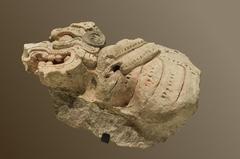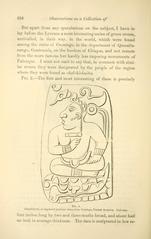Chinkultic Visiting Hours, Tickets, and Comprehensive Guide to Chiapas Historical Sites
Date: 14/06/2025
Introduction
Chinkultic, located in the highlands of Chiapas, Mexico, is a significant Maya archaeological site that stands as a testament to the region’s ancient history and vibrant living culture. The name “Chinkultic,” meaning “stepped-cenote” in Yucatec Maya, reflects the site’s defining natural feature—a deep cenote integral to Maya ritual practice. Occupied primarily during the Late Classic period (c. AD 600–900) and into the Postclassic era, Chinkultic was a regional center known for its ceremonial architecture, numerous carved stelae, and a well-preserved ballcourt (Lonely Planet; The Mayan Ruins Website).
Set within the stunning landscape of Montebello Lakes National Park near Comitán de Domínguez, Chinkultic harmoniously blends monumental ruins with pine-oak forests, lakes, and rolling hills. Visitors can explore over 200 mounds and structures, including the Acropolis, Plaza Hundida (Sunken Plaza), and the sacred Cenote Agua Azul, which yield insights into ancient Maya religious practices (Wikipedia; Sailingstone Travel).
As a living cultural landmark, Chinkultic connects travelers with local Maya communities and traditions. Its tranquil setting, archaeological importance, and proximity to attractions like the Montebello Lakes and Comitán make it a rewarding destination for those interested in Mexico’s history and indigenous heritage (Mexperience; The Twirling Traveler).
Contents
- Introduction
- Historical Overview and Cultural Significance
- Archaeological Site Layout and Major Features
- Visitor Information: Hours, Tickets, and Travel Tips
- Nearby Attractions and Accommodations
- Living Maya Heritage and Responsible Tourism
- Frequently Asked Questions (FAQ)
- Conclusion and Further Resources
Historical Overview and Cultural Significance
Origins and Development
Chinkultic emerged as a regional Maya center during the Late Classic period (c. AD 600–900). Unlike the larger cities of Palenque or Tikal, Chinkultic’s influence was more local, but its strategic location near fertile valleys and lakes supported agricultural success, trade, and ceremonial activity. The site’s occupation persisted into the Postclassic era, suggesting resilience in the face of regional change (Lonely Planet).
Political and Cultural Context
Chinkultic participated in the wider network of Maya city-states, as evidenced by its carved stelae, which commemorate rulers, accessions, and events. The site’s architecture—pyramids, ballcourt, and plazas—reflects broader Maya patterns, while its ballgame facilities indicate ritual and social significance.
Archaeological Site Layout and Major Features
General Site Organization
Chinkultic spans approximately 40 hectares, with over 200 mounds, though only a fraction are excavated (Wikipedia; The Mayan Ruins Website). The ruins are organized into several architectural groups:
- Group A (Acropolis): The highest terrace, accessible by a monumental stairway, offers panoramic views. Structures here include El Mirador pyramid and ceremonial platforms. The nearby Cenote Agua Azul served as a ritual site with offerings such as pottery and obsidian (Sailingstone Travel).
- Group B (Plaza Hundida): A sunken ceremonial plaza, possibly used for water rituals or astronomical observation.
- Group C (Ballcourt and Stelae Plaza): Features a classic Maya ballcourt and numerous stelae depicting rulers and glyphs (Lonely Planet).
- Other Groups (D and E): Less explored, likely residential or administrative (Arqueología Mexicana).
Key Structures
- Ballcourt: Dedicated in 591 CE, with a carved stela at its base. The Chinkultic Ball Player disc, an important artifact, is now in the National Museum of Anthropology (The Mayan Ruins Website).
- Stelae: At least 38 carved stelae, many with historical inscriptions (Wikipedia).
- Cenote Agua Azul: A dramatic, 50-meter deep sinkhole, central to ritual offerings and religious practices.
- Temple of the Sun: Two pyramids joined by a bridge, used for ceremonies (Mundo Maya Travel).
Natural Setting
The site’s integration with pine-oak forests, lakes, and cenotes provides a striking backdrop, with scenic viewpoints over Montebello Lakes National Park (Mail LacGeo). Biodiversity is abundant, making the area ideal for nature walks and photography.
Visitor Information: Hours, Tickets, and Travel Tips
Visiting Hours and Tickets
- Hours: Open daily from 8:00 AM to 5:00 PM.
- Admission: Tickets are typically 50–70 MXN for adults, with discounts for students and seniors. Tickets are available on-site; always check for updates before visiting (The Twirling Traveler; Mexperience).
Accessibility and Facilities
- Terrain: Includes steep paths and stairs, especially to the Acropolis. Accessibility for those with mobility issues is limited.
- Facilities: Basic amenities (restrooms, shaded areas) are near the entrance; no food or lodging on-site.
Getting There
- Location: About 46–48 km southeast of Comitán de Domínguez, within Montebello Lakes National Park.
- Transport: Best reached by car; local tours are also available. Public transport is limited. Use GPS or maps as signage can be sparse (Mexperience).
Travel Tips
- Best Time: Visit during the dry season (November–April) for optimal weather and road conditions.
- What to Bring: Comfortable walking shoes, water, sun protection, insect repellent, and snacks. Bring cash in small denominations.
- Photography: Allowed throughout the site. Tripods require a permit and fee (Mexperience).
Nearby Attractions and Accommodations
- Montebello Lakes National Park: Over 50 lakes with hiking, boating, and swimming (Sailingstone Travel).
- Tenam Puente: Another Maya ruin nearby with unique architectural features.
- Comitán: The nearest town offering hotels, hostels, restaurants, and markets.
- San Cristóbal de las Casas & Tuxtla Gutiérrez: Larger cities with more accommodations and cultural experiences (Travel Made Me Do It).
Living Maya Heritage and Responsible Tourism
Indigenous Communities and Cultural Continuity
Chinkultic is surrounded by vibrant Maya communities, including the Tzeltal and Tzotzil peoples, who maintain languages, clothing, rituals, and artisanal traditions (mexicohistorico.com). Festivals, such as Día de los Muertos and local harvest ceremonies, often blend ancient Maya and Catholic traditions.
Community Stewardship
Local groups actively participate in site conservation, blending traditional knowledge with modern preservation. Responsible tourism—supporting local guides, respecting site rules, and purchasing local crafts—ensures benefits for communities and site integrity (mexicohistorico.com).
Visitor Etiquette
- Avoid climbing on fragile or unmarked ruins.
- Do not remove artifacts or plants.
- Ask permission before photographing people or ceremonies.
- Respect sacred areas, especially during local festivals.
Frequently Asked Questions (FAQ)
Q: What are the Chinkultic visiting hours?
A: Daily, 8:00 AM to 5:00 PM.
Q: How much are Chinkultic tickets?
A: 50–70 MXN for adults; discounts for students and seniors.
Q: How do I get to Chinkultic?
A: By car from Comitán (45–50 minutes), or with a guided tour.
Q: Are guided tours available?
A: Yes, tours can be arranged in Comitán or on-site.
Q: Is the site accessible for people with limited mobility?
A: Accessibility is limited due to uneven terrain and stairs.
Q: Are there facilities or food vendors at the site?
A: Only basic facilities; nearest food and lodging are in Comitán.
Q: What should I bring?
A: Water, sun protection, insect repellent, comfortable shoes, cash, and respectful clothing.
Visuals and Interactive Resources
Conclusion
Chinkultic offers a unique blend of archaeological intrigue, natural beauty, and living Maya culture. With accessible visiting hours, affordable tickets, and the guidance of local experts, visitors can experience the depth of Chiapas’s history while supporting sustainable tourism. Plan your trip for the dry season, prepare for uneven terrain, and embrace the opportunity to engage with local communities and traditions.
For further details on visiting Chinkultic, consult the official Chiapas tourism website and download the Audiala app for real-time updates, guided tours, and cultural insights.
Experience Chinkultic—where ancient history and vibrant tradition come together in the heart of Chiapas.

